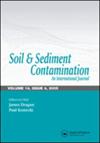更好地表征土壤中的砷和铬:一个实地规模的例子
IF 1.5
4区 环境科学与生态学
Q4 ENVIRONMENTAL SCIENCES
引用次数: 14
摘要
土壤中砷和铬的表征(以及场地修复决策)通常基于总浓度结果和美国环保署TCLP结果。通过应用地质统计学、选择性提取实验室程序和土壤矿物学的X射线衍射测定来进一步评估土壤介质中的砷和铬,提供了有价值的附加信息。砷和铬污染的土壤在一个化学生产设施代表了该方法应用的一个案例研究。从0到6英尺深,土壤的特征是斑驳的,黄褐色的,淤泥和粘土带细砂,向下分级为浅黄褐色,微砂,云母,细砂,以小的,灰色的,叶状的,岩屑碎片和白云母为主。总砷和总铬集中在上层粉砂和粘土中,但更容易从下层砂土中浸出,这表明土壤成分的分配是基于土壤成分的。选择性提取数据表明砷是主要的…本文章由计算机程序翻译,如有差异,请以英文原文为准。
BETTER CHARACTERIZATION OF ARSENIC AND CHROMIUM IN SOILS: A FIELDSCALE EXAMPLE
The characterization of arsenic and chromium in soil (and site remediation decisions) is commonly based on total concentration results and U.S. EPA TCLP results. Further evaluation of arsenic and chromium within the soil media by application of geostatistlcs, selective extraction laboratory procedures, and X‐ray diffraction determination of soil mineralogy provides valuable additional information. Arsenic‐and chromium‐contaminated soils at a chemical manufacturing facility represent a case study for application of this approach. From 0 to 6 ft deep, the soils are characterized by mottled, yellowish brown, silt and clay with fine sand, grading downward into light yellowish brown, sllty, micaceous, fine sand, dominated by small, gray, foliated, lithic fragments and muscovite. Total arsenic and chromium are concentrated in the upper silt and clay, but are more readily leached from the lower sandy soil, suggesting partitioning based on soil composition. Selective extraction data Indicate that arsenic is prima...
求助全文
通过发布文献求助,成功后即可免费获取论文全文。
去求助
来源期刊

Soil & Sediment Contamination
环境科学-环境科学
CiteScore
4.20
自引率
10.00%
发文量
53
审稿时长
2.2 months
期刊介绍:
When it comes to assessing and mitigating contaminated soils and sediments, there is no substitute for having the very latest tools, techniques and methodologies at your fingertips to help you deal with these issues efficiently and cost-effectively.
This is just the kind of essential expertise you’ll only find in Soil and Sediment Contamination . This internationally, peer-reviewed publication focuses on soil and sediment contamination from:
-Sludges-
Petroleum-
Petrochemicals-
Chlorinated hydrocarbons-
Pesticides-
Lead and other heavy metals.
Get detailed descriptions of all the latest and most efficient offsite and in situ remediation techniques, strategies for assessing health effects and hazards, and tips for dealing with everyday regulatory and legal issues. With the state-of-the-art tools that Soil and Sediment Contamination provides, you can successfully assess, mitigate, and solve both rural and urban soil contamination problems as efficiently and economically as possible.
 求助内容:
求助内容: 应助结果提醒方式:
应助结果提醒方式:


